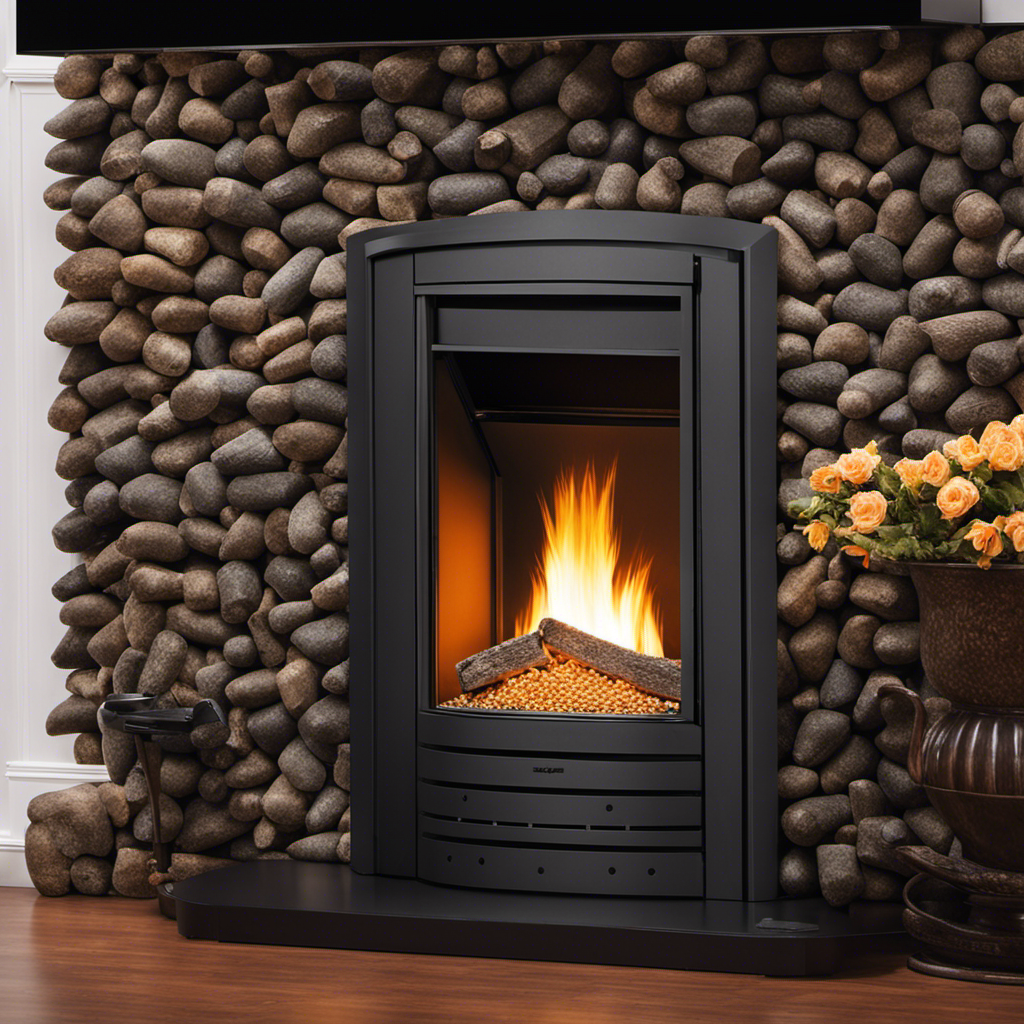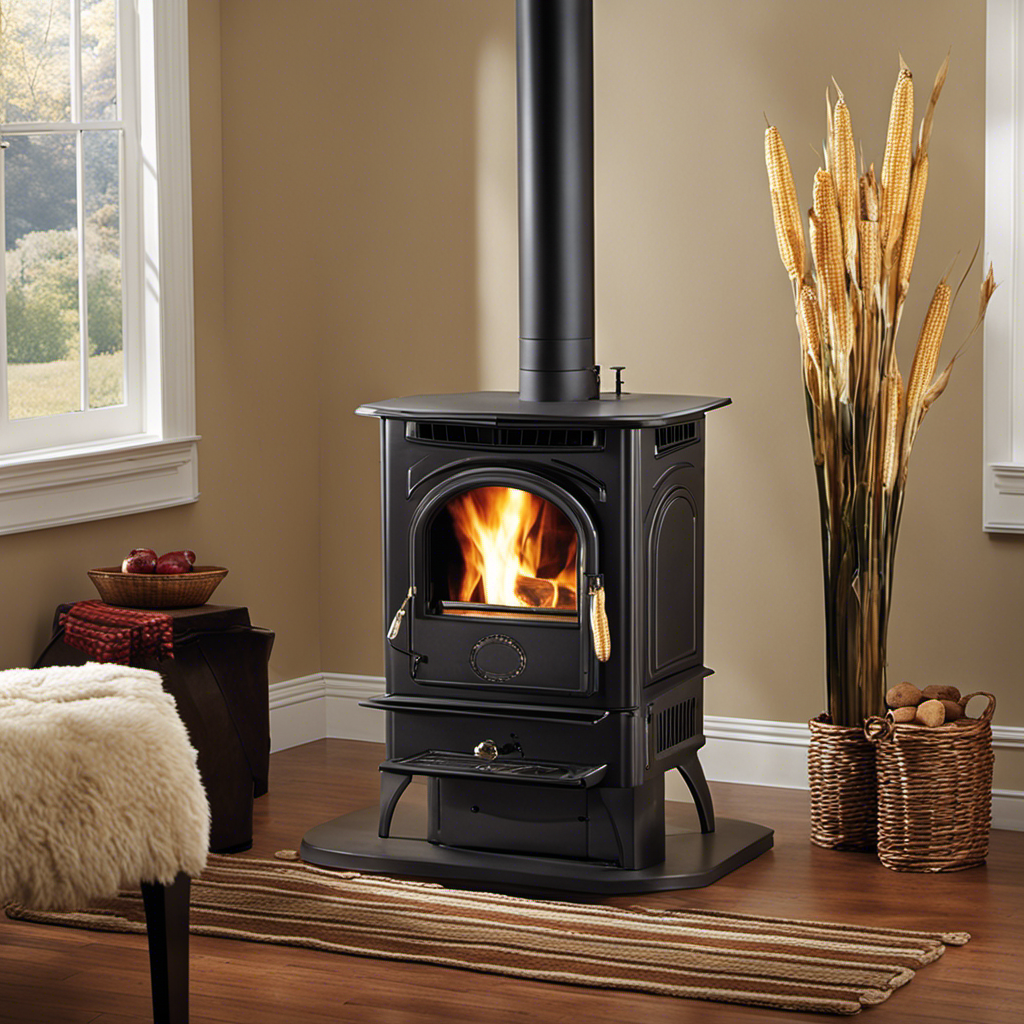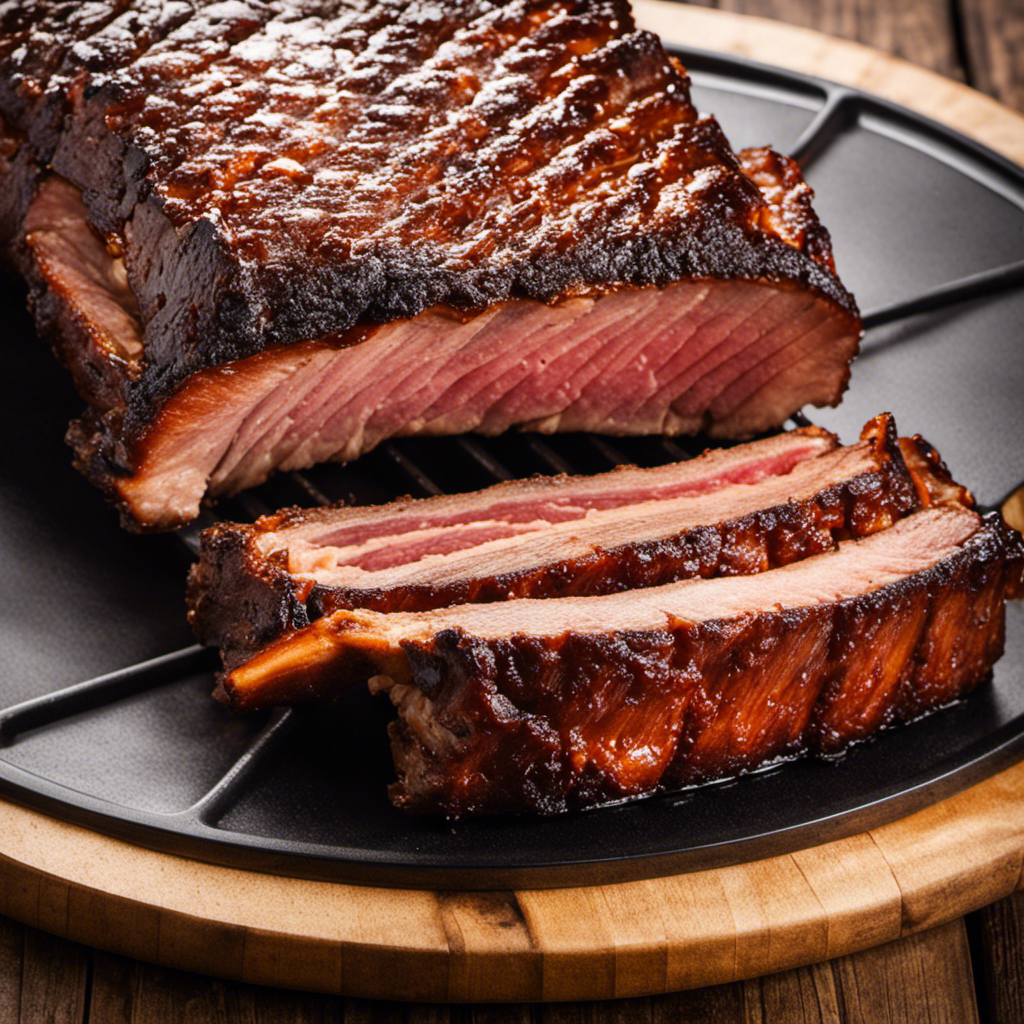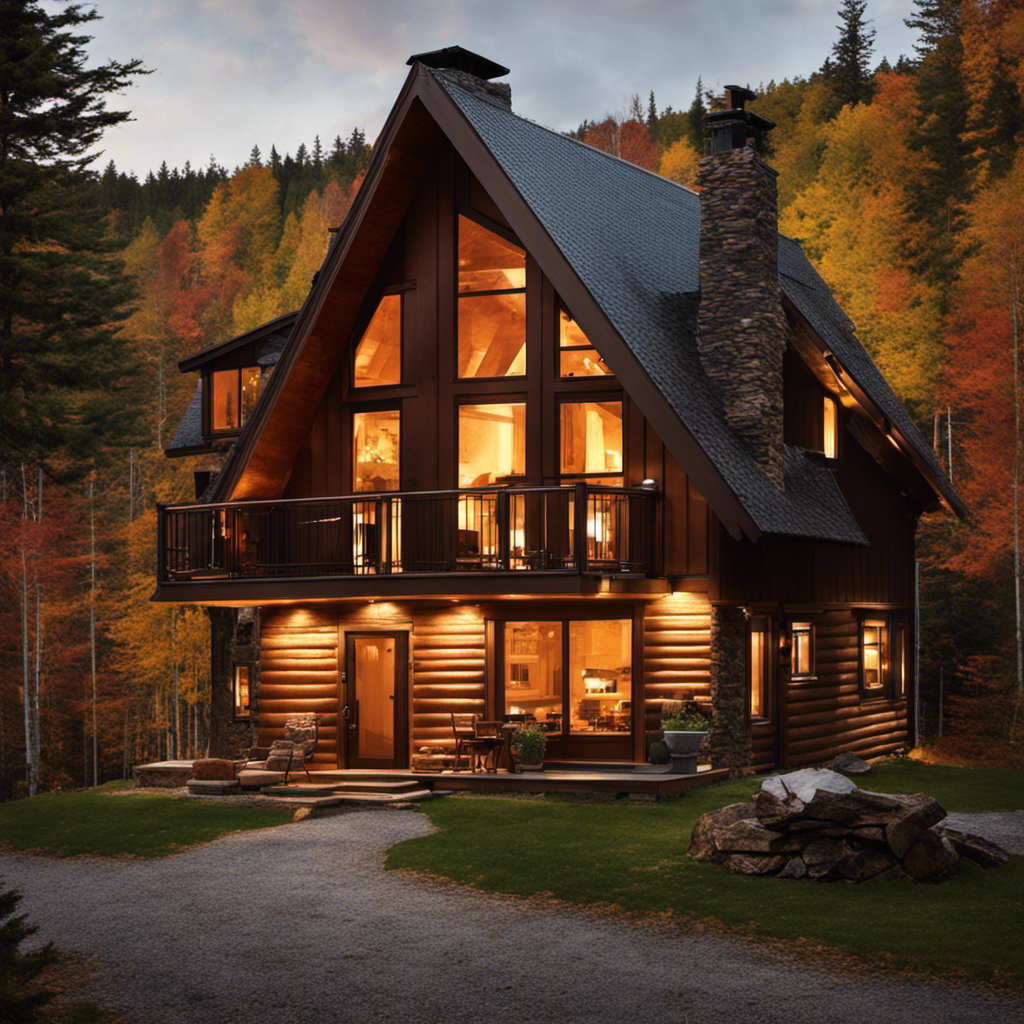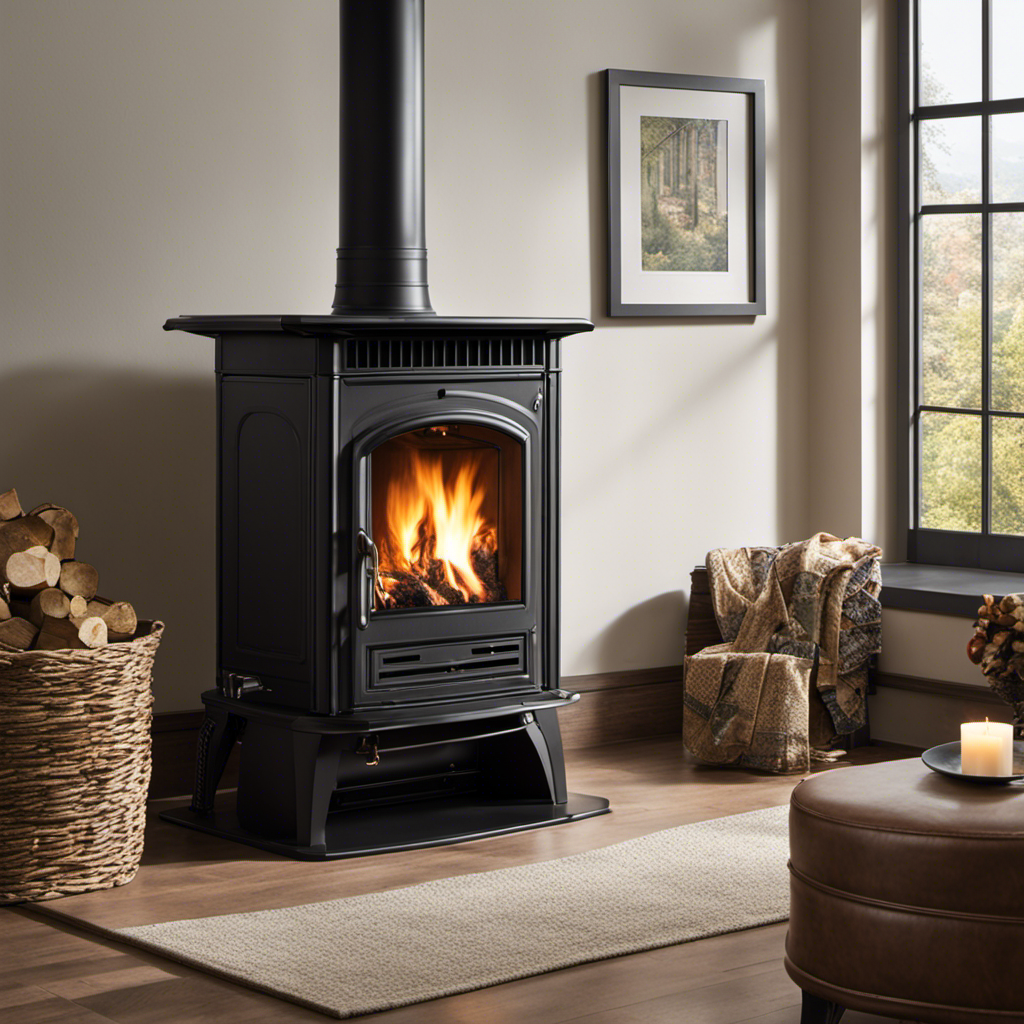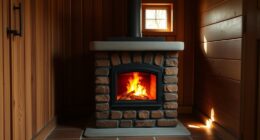I am deeply intrigued by wood pellet fireplaces due to their advanced technology and efficiency in heating. These modern marvels utilize intricate combustion processes, sophisticated pellet storage and dispensing systems, and state-of-the-art temperature control mechanisms.
With a keen eye for safety and efficiency, they boast ventilation and airflow systems that ensure optimal heat output.
In this article, I will delve into the intricate workings of wood pellet fireplaces, exploring their inner mechanisms and providing insights into their maintenance and troubleshooting.
Key Takeaways
- Wood pellet fireplaces have high heat output and low emissions, making them more efficient than traditional fireplaces.
- The efficiency of the combustion process in wood pellet fireplaces minimizes fuel consumption.
- The storage container and feeding mechanism in wood pellet fireplaces affect the efficiency of pellet storage and delivery.
- Wood pellet fireplaces use various ignition methods for quick and efficient start-up, allowing for easy operation.
Combustion Process
To understand how wood pellet fireplaces work, you need to know that the combustion process is what generates heat and creates the cozy atmosphere you love. The combustion process begins when the wood pellets are fed into the fireplace’s burn pot. The burn pot is equipped with an igniter that ignites the pellets, starting the combustion process.
As the pellets burn, they release heat and produce a flame. The combustion process in wood pellet fireplaces is highly efficient, with a high heat output and low emissions. This is because the pellets are made from compressed sawdust and other wood waste, which burn cleanly and efficiently. Compared to traditional wood-burning fireplaces, wood pellet fireplaces have a lower environmental impact due to their higher combustion process efficiency.
Now, let’s move on to the pellet storage and feeding mechanism.
Pellet Storage and Feeding Mechanism
When it comes to pellet storage options, there are a few key factors to consider.
First, the type of storage container you choose will determine how efficiently the pellets are stored and protected from moisture and pests.
Additionally, the size of the storage container will depend on the amount of pellets you plan to use and how often you want to refill it.
Moving on to the feeding mechanism efficiency, it is crucial to select a system that can deliver the pellets to the combustion chamber consistently and without any issues.
Factors such as the design of the auger, the motor power, and the overall construction of the feeding mechanism will all play a role in ensuring a smooth and efficient pellet delivery process.
Pellet Storage Options
You can store wood pellets in various ways, such as using bags, bins, or even dedicated storage rooms. When considering pellet storage options, it is important to consider the pellet storage capacity and the pellet storage location.
The storage capacity refers to how much pellets can be stored at a given time, while the storage location refers to where the pellets will be kept. Bags are a common storage option, with sizes ranging from 10 to 40 pounds. Bins are another option, usually made of plastic or metal, and can hold larger quantities of pellets. Dedicated storage rooms are ideal for those with larger pellet storage needs. These rooms are designed to efficiently store and organize a large number of pellets.
Now, let’s move on to the next section and discuss the feeding mechanism efficiency.
Feeding Mechanism Efficiency
For optimal efficiency, consider the feeding mechanism of your fireplace. The design of the feeding mechanism plays a crucial role in ensuring a consistent and reliable fuel supply.
A well-designed feeding mechanism should be able to handle different pellet sizes and shapes without any issues. It should also have a mechanism for adjusting the feed rate, allowing you to control the burn rate and heat output of your fireplace.
Additionally, the feeding mechanism should be able to handle pellets of varying qualities. Pellet quality can vary depending on factors such as moisture content and density. A good feeding mechanism should be able to handle pellets of different qualities without jamming or clogging.
By choosing a fireplace with a well-designed feeding mechanism, you can ensure optimal performance and hassle-free operation.
Now, let’s move on to the next section about ignition and start-up.
Ignition and Start-up
To ignite and start up a wood pellet fireplace, simply press the ignition button and wait for the pellets to catch fire. Here are the steps to follow for a successful start-up:
- Fill the hopper with wood pellets, ensuring you don’t overfill.
- Open the air intake damper to allow for proper airflow.
- Turn on the fireplace and set the desired temperature on the control panel.
- Press the ignition button and wait for the fire to ignite the pellets.
Wood pellet fireplaces utilize various ignition methods, such as hot rods or igniters, to start the combustion process. These methods ensure a quick and efficient start-up, allowing you to enjoy the warmth and ambiance of a wood fire.
Once the pellets have caught fire, the control systems and temperature regulation come into play, ensuring a steady and controlled burn.
Control Systems and Temperature Regulation
When it comes to controlling the temperature in a space, two key factors to consider are thermostat accuracy and efficiency, as well as the choice between manual and automated control.
Thermostat accuracy is crucial for maintaining the desired temperature, as even a small deviation can lead to discomfort or energy waste.
Efficiency, on the other hand, focuses on how effectively the thermostat can regulate the temperature without excessive energy consumption.
The decision between manual and automated control depends on personal preferences and the level of convenience and control desired.
Thermostat Accuracy and Efficiency
You can improve the accuracy and efficiency of your wood pellet fireplace thermostat by regularly cleaning and calibrating it. The thermostat calibration ensures accurate temperature readings, allowing for precise control of the heating process. This is important for maintaining a comfortable indoor environment and optimizing energy consumption. When the thermostat is not calibrated correctly, it may lead to temperature fluctuations and increased energy usage.
Cleaning the thermostat is also crucial in preventing dust and debris from interfering with its operation. Regular maintenance and calibration of the thermostat will ensure that your wood pellet fireplace operates at its best, providing efficient and reliable heating.
Now, let’s explore the different control options available for wood pellet fireplaces, including manual versus automated control.
Manual Versus Automated Control
Using an automated control system for your wood pellet fireplace allows for easier temperature adjustments and more precise heating. With manual control, you have to constantly monitor and adjust the temperature, which can be inconvenient and time-consuming. However, with automated control, you can set up a schedule for your fireplace to turn on and off at specific times, ensuring that your home is always at your desired temperature. This not only provides convenience but also helps in optimizing energy consumption. By scheduling your fireplace to turn on only when needed, you can effectively manage your energy usage and reduce unnecessary heating. The table below illustrates the benefits of automated scheduling and its impact on energy consumption.
| Benefits of Automated Scheduling | Impact on Energy Consumption |
|---|---|
| Easier temperature adjustments | Optimal energy usage |
| More precise heating | Reduced energy waste |
Now, let’s move on to the next section about ash disposal and cleaning.
Ash Disposal and Cleaning
To properly dispose of ashes and keep your wood pellet fireplace clean, simply wait for the ashes to cool down before scooping them out and disposing them in a designated ash can or container. Ashes should never be disposed of in the regular trash, as they can still contain hot embers that may cause a fire. It is important to use a metal scoop or shovel to remove the ashes, as plastic tools may melt due to the high temperatures.
Once the ashes are removed, it is recommended to clean the fireplace regularly to prevent the buildup of soot and debris. This can be done by using a soft brush or vacuum cleaner designed for fireplace use. Regular maintenance and cleaning will not only ensure the proper functioning of your wood pellet fireplace but also prolong its lifespan.
When it comes to heat output and efficiency, wood pellet fireplaces are designed to provide optimal heat while minimizing fuel consumption. The heat output of a wood pellet fireplace is measured in British Thermal Units (BTUs), indicating the amount of heat produced per hour. The efficiency of a wood pellet fireplace is determined by how effectively it converts fuel into heat.
Higher efficiency means less fuel is wasted, resulting in lower operating costs and reduced environmental impact. Wood pellet fireplaces achieve high efficiency through the use of advanced combustion technology and precise control systems. These systems regulate the amount of fuel being fed into the fireplace, ensuring a consistent and efficient burn.
Heat Output and Efficiency
When it comes to heat output and efficiency, wood pellet fireplaces are designed to provide optimal warmth while minimizing fuel consumption. These fireplaces use wood pellets as fuel, which are made from compacted sawdust and other wood waste materials.
The pellets are fed into a combustion chamber, where they are ignited by an electric igniter. The heat generated from the burning pellets is then distributed throughout the room using a fan or blower system. This ensures that the warmth is evenly spread and reaches every corner of the space.
The efficiency of wood pellet fireplaces is measured by their ability to convert the energy from the burning pellets into usable heat. By carefully controlling the air intake and combustion process, these fireplaces can achieve high levels of efficiency, thus minimizing fuel consumption.
In the next section, we will explore the importance of proper ventilation and airflow in wood pellet fireplaces.
Ventilation and Airflow
For optimal performance, make sure you properly ventilate and maintain a steady airflow in your wood pellet fireplace. The ventilation design of your fireplace plays a crucial role in ensuring efficient combustion and heat output.
Proper air circulation is necessary to supply oxygen to the fire and remove combustion byproducts, such as carbon monoxide and other harmful gases. The most common type of ventilation system in wood pellet fireplaces is direct venting, which utilizes a pipe that brings in fresh air from the outside and vents out the exhaust gases.
This system not only ensures a constant supply of oxygen but also prevents the release of harmful gases into your living space. It is important to regularly inspect and clean the ventilation system to maintain optimal airflow and prevent any blockages.
Now, let’s move on to the next section, where we will discuss the safety features and regulations associated with wood pellet fireplaces.
Safety Features and Regulations
As we discussed in the previous section, proper ventilation and airflow are crucial for the efficient operation of wood pellet fireplaces. However, safety is also a top priority when it comes to these appliances.
Fireplace installation should always be done by a professional to ensure compliance with safety regulations. One important safety feature of wood pellet fireplaces is carbon monoxide detection. Carbon monoxide is a colorless and odorless gas that can be produced during the combustion process. It is extremely dangerous and can lead to serious health problems or even death if not detected.
That’s why wood pellet fireplaces are equipped with carbon monoxide detectors that sound an alarm if the gas levels exceed a certain threshold. This ensures the safety of the occupants and provides peace of mind.
Now, let’s move on to the next section to learn about the maintenance and troubleshooting of wood pellet fireplaces.
Maintenance and Troubleshooting
To ensure the efficient operation of your wood pellet fireplace, regular maintenance and troubleshooting are necessary. Proper maintenance not only extends the lifespan of your fireplace but also ensures optimal performance. Here are some maintenance tips to keep your wood pellet fireplace in top condition.
Firstly, clean the burn pot regularly to remove any ash or debris. A clogged burn pot can affect the combustion process and reduce heat output. Additionally, inspect and clean the exhaust vent to prevent any blockages that could hinder airflow.
Secondly, check the hopper for any pellet clumps or foreign objects that may cause feed issues. It’s essential to keep the pellets flowing smoothly into the burn pot for consistent heat.
Lastly, troubleshoot common issues such as error codes, ignition problems, or poor heat output. Consult the manufacturer’s manual for specific troubleshooting steps or contact a professional if needed.
What Are the Differences Between Wood Pellet Fireplaces and Wood Pellet Fireplace Inserts?
Wood pellet fireplace inserts are designed to be inserted into an existing fireplace, while wood pellet fireplaces are standalone units. Fireplace inserts are ideal for those who want to upgrade their traditional fireplace, while standalone fireplaces are great for those without an existing fireplace. Both offer efficient heating and eco-friendly fuel.
What Is the Difference Between Wood Pellet Fireplaces and Wood Pellet Fireplace Inserts?
Wood pellet fireplace inserts are designed to be inserted into an existing traditional fireplace, whereas wood pellet fireplaces are stand-alone units that can be installed just about anywhere. Both use wood pellets as a fuel source but differ in their installation and placement within a home.
Frequently Asked Questions
Can Wood Pellet Fireplaces Be Used as the Primary Heat Source for a Home?
Yes, wood pellet fireplaces can be used as the primary heat source for a home. They are highly efficient, providing consistent heat and reducing energy costs. However, disadvantages include the need for regular maintenance and reliance on a steady supply of wood pellets.
Are Wood Pellet Fireplaces Environmentally Friendly?
Wood pellet fireplaces are environmentally friendly due to their high efficiency and low emissions. They minimize air pollution by burning clean, renewable wood pellets. Their advanced combustion technology ensures minimal impact on the environment while providing efficient heat for homes.
How Long Do Wood Pellets Typically Last Before Needing to Be Refilled?
Wood pellets typically last for several hours before needing to be refilled in a wood pellet fireplace. This is due to the high efficiency of wood pellet combustion and the benefits of using wood pellets as a fuel source.
Can Wood Pellet Fireplaces Be Used in Areas With Strict Air Quality Regulations?
Yes, wood pellet fireplaces can be used in areas with strict air quality regulations. The efficiency of wood pellet fireplaces reduces emissions, minimizing their impact on air quality and making them compliant with regulations.
Can Wood Pellet Fireplaces Be Used With a Thermostat to Control the Temperature?
Yes, wood pellet fireplaces can be used with a thermostat to control the temperature. They are compatible with various thermostats and offer precise temperature control capabilities, allowing you to adjust the heat output according to your preferences.
Conclusion
In conclusion, wood pellet fireplaces are marvels of modern engineering. The intricate combustion process, coupled with the efficient storage and feeding mechanism, ensures a constant and reliable source of heat.
The ignition and start-up procedures are seamless, thanks to advanced control systems and temperature regulation. Ash disposal and cleaning are made effortless, leaving you with more time to enjoy the cozy warmth.
With proper ventilation and airflow, these fireplaces not only provide comfort but also adhere to strict safety regulations. Maintenance and troubleshooting are simplified, making these fireplaces a wise choice for any homeowner.
It’s ironic how something so technical and detailed can bring such warmth and emotion into our lives.
Logan’s affair with adventure began in childhood. He hailed from a small town where vast forests bordered one side and endless shores stretched on the other. His days were spent exploring uncharted woods, climbing tall trees, or listening to the tales of old sailors. This early immersion in a world brimming with stories and mysteries became the foundation of his passion for writing.

